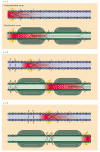By agreement with the publisher, this book is accessible by the search feature, but cannot be browsed.
NCBI Bookshelf. A service of the National Library of Medicine, National Institutes of Health.
Purves D, Augustine GJ, Fitzpatrick D, et al., editors. Neuroscience. 2nd edition. Sunderland (MA): Sinauer Associates; 2001.

Neuroscience. 2nd edition.
Show detailsThe rate of action potential conduction limits the flow of information within the nervous system. It is not surprising, then, that various mechanisms have developed to optimize the propagation of action potentials along axons. Because action potential conduction requires passive and active flow of current (see Figure 3.12), the rate of action potential propagation is determined by both of these phenomena. One way of improving passive current flow is to increase the diameter of an axon, which effectively decreases the internal resistance to passive current flow (see Box C). The consequent increase in action potential conduction velocity presumably explains why giant axons evolved in invertebrates such as squid, and why rapidly conducting axons in all animals tend to be larger than slowly conducting ones.
Another strategy to improve the passive flow of electrical current is to insulate the axonal membrane, reducing the ability of current to leak out of the axon and thus increasing the distance along the axon that a given local current can flow passively (see Box C). This strategy is evident in the myelination of axons, a process by which oligodendrocytes in the central nervous system (and Schwann cells in the peripheral nervous system) wrap the axon in myelin, which consists of multiple layers of closely opposed glial membranes (Figure 3.13; see also Chapter 1). By acting as an electrical insulator, myelin greatly speeds up action potential conduction (Figure 3.14). For example, whereas unmyelinated axon conduction velocities range from about 0.5 to 10 m/s, myelinated axons can conduct at velocities up to 150 m/s. The major reason underlying this marked increase in speed is that the time-consuming process of action potential generation occurs only at specific points along the axon, called nodes of Ranvier, where there is a gap in the myelin wrapping (see Figure 1.4F). If the entire surface of an axon were insulated, there would be no place for current to flow out of the axon and action potentials could not be generated. As it happens, an action potential generated at one node of Ranvier elicits current that flows passively within the myelinated segment until the next node is reached. This local current flow then generates an action potential in the neighboring segment, and the cycle is repeated along the length of the axon. Because current flows across the neuronal membrane only at the nodes (see Figure 3.13), this type of propagation is called saltatory, meaning that the action potential jumps from node to node. Not surprisingly, loss of myelin, as occurs in diseases such as multiple sclerosis, causes a variety of serious neurological problems (Box D).

Figure 3.13
Saltatory action potential conduction along a myelinated axon. (A) Diagram of a myelinated axon. (B) Local current in response to action potential initiation at a particular site flows locally, as described in Figure 3.12. However, the presence of myelin (more...)

Figure 3.14
Comparison of speed of action potential conduction in unmyelinated (upper) and myelinated (lower) axons.
Box D
Multiple Sclerosis.
- PubMedLinks to PubMed
- Increased Conduction Velocity as a Result of Myelination - NeuroscienceIncreased Conduction Velocity as a Result of Myelination - Neuroscience
Your browsing activity is empty.
Activity recording is turned off.
See more...